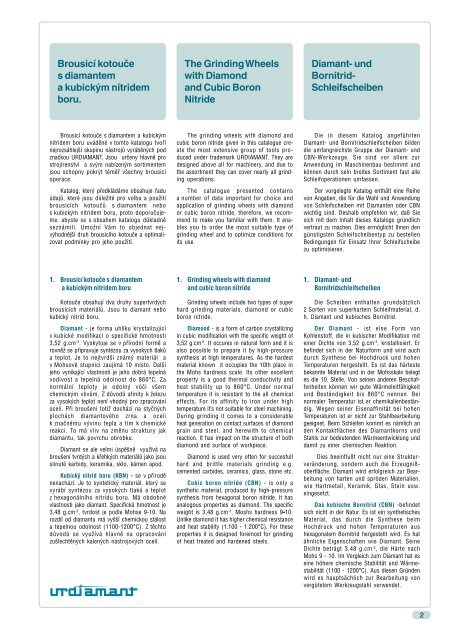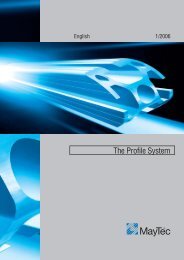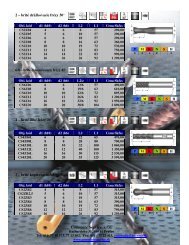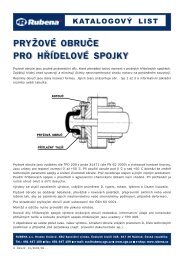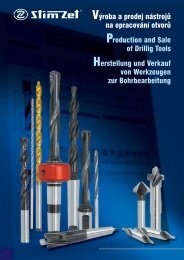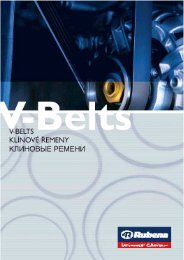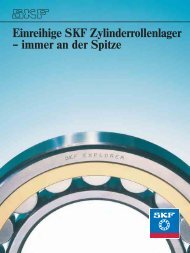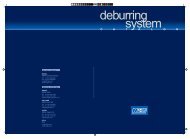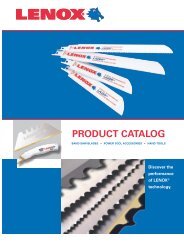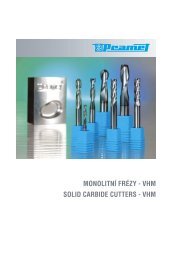brousicí kotouče z diamantu a kubického nitridu boru grinding ...
brousicí kotouče z diamantu a kubického nitridu boru grinding ...
brousicí kotouče z diamantu a kubického nitridu boru grinding ...
You also want an ePaper? Increase the reach of your titles
YUMPU automatically turns print PDFs into web optimized ePapers that Google loves.
Brousicí <strong>kotouče</strong><br />
s diamantem<br />
a kubickým nitridem<br />
<strong>boru</strong>.<br />
The Grinding Wheels<br />
with Diamond<br />
and Cubic Boron<br />
Nitride<br />
Diamant- und<br />
Bornitrid-<br />
Schleifscheiben<br />
Brousicí <strong>kotouče</strong> s diamantem a kubickým<br />
nitridem <strong>boru</strong> uváděné v tomto katalogu tvoří<br />
nejrozsáhlejší skupinu nástrojů vyráběných pod<br />
značkou URDIAMANT. Jsou určeny hlavně pro<br />
strojírenství a svým nabízeným sortimentem<br />
jsou schopny pokrýt téměř všechny <strong>brousicí</strong><br />
operace.<br />
Katalog, který předkládáme obsahuje řadu<br />
údajů, které jsou důležité pro volbu a použití<br />
<strong>brousicí</strong>ch kotoučů s diamantem nebo<br />
s kubickým nitridem <strong>boru</strong>, proto doporučujeme,<br />
abyste se s obsahem katalogu důkladně<br />
seznámili. Umožní Vám to objednat nejvýhodnější<br />
druh <strong>brousicí</strong>ho <strong>kotouče</strong> a optimalizovat<br />
podmínky pro jeho použití.<br />
The <strong>grinding</strong> wheels with diamond and<br />
cubic boron nitride given in this catalogue create<br />
the most extensive group of tools produced<br />
under trademark URDIAMANT. They are<br />
designed above all for machinery, and due to<br />
the assortment they can cover nearly all <strong>grinding</strong><br />
operations.<br />
The catalogue presented contains<br />
a number of data important for choice and<br />
application of <strong>grinding</strong> wheels with diamond<br />
or cubic boron nitride, therefore, we recommend<br />
to make you familiar with them. It enables<br />
you to order the most suitable type of<br />
<strong>grinding</strong> wheel and to optimize conditions for<br />
its use.<br />
Die in diesem Katalog angeführten<br />
Diamant- und Bornitridschleifscheiben bilden<br />
die umfangreichste Gruppe der Diamant- und<br />
CBN-Werkzeuge. Sie sind vor allem zur<br />
Anwendung im Maschinenbau bestimmt und<br />
können durch sein breites Sortiment fast alle<br />
Schleifoperationen umfassen.<br />
Der vorgelegte Katalog enthält eine Reihe<br />
von Angaben, die für die Wahl und Anwendung<br />
von Schleifscheiben mit Diamanten oder CBN<br />
wichtig sind. Deshalb empfehlen wir, daß Sie<br />
sich mit dem Inhalt dieses Katalogs gründlich<br />
vertraut zu machen. Dies ermöglicht Ihnen den<br />
günstigsten Schleifscheibentyp zu bestellen<br />
Bedingungen für Einsatz Ihrer Schleifscheibe<br />
zu optimisieren.<br />
1. Brousicí <strong>kotouče</strong> s diamantem<br />
a kubickým nitridem <strong>boru</strong><br />
Kotouče obsahují dva druhy supertvrdých<br />
brousících materiálů. Jsou to diamant nebo<br />
kubický nitrid <strong>boru</strong>.<br />
Diamant - je forma uhlíku krystalizující<br />
v kubické modifikaci o specifické hmotnosti<br />
3,52 g.cm -3 . Vyskytuje se v přírodní formě a<br />
rovněž se připravuje syntézou za vysokých tlaků<br />
a teplot. Je to nejtvrdší známý materiál a<br />
v Mohsově stupnici zaujímá 10 místo. Další<br />
jeho vynikající vlastností je jeho dobrá tepelná<br />
vodivost a tepelná odolnost do 860°C. Za<br />
normální teploty je odolný vůči všem<br />
chemickým vlivům. Z důvodů afinity k železu<br />
za vysokých teplot není vhodný pro zpracování<br />
oceli. Při broušení totiž dochází na styčných<br />
plochách diamantového zrna a oceli<br />
k značnému vývinu tepla a tím k chemické<br />
reakci. To má vliv na změnu struktury jak<br />
<strong>diamantu</strong>, tak povrchu obrobku.<br />
Diamant se ale velmi úspěšně využívá na<br />
broušení tvrdých a křehkých materiálů jako jsou<br />
slinuté karbidy, keramika, sklo, kámen apod.<br />
Kubický nitrid <strong>boru</strong> (KBN) - se v přírodě<br />
nenachází. Je to syntetický materiál, který se<br />
vyrábí syntézou za vysokých tlaků a teplot<br />
z hexagonálního <strong>nitridu</strong> <strong>boru</strong>. Má obdobné<br />
vlastnosti jako diamant. Specifická hmotnost je<br />
3,48 g.cm -3 , tvrdost je podle Mohse 9-10. Na<br />
rozdíl od <strong>diamantu</strong> má vyšší chemickou stálost<br />
a tepelnou odolnost (1100-1200°C). Z těchto<br />
důvodů se využívá hlavně na opracování<br />
zušlechtěných kalených nástrojových ocelí.<br />
1. Grinding wheels with diamond<br />
and cubic boron nitride<br />
Grinding wheels include two types of super<br />
hard <strong>grinding</strong> materials, diamond or cubic<br />
boron nitride.<br />
Diamond - is a form of carbon crystallizing<br />
in cubic modification with the specific weight of<br />
3,52 g.cm -3 . It occures in natural form and it is<br />
also possible to prepare it by high-pressure<br />
synthesis at high temperatures. As the hardest<br />
material known it occupies the 10th place in<br />
the Mohs hardness scale. Its other excellent<br />
property is a good thermal conductivity and<br />
heat stability up to 860°C. Under normal<br />
temperature it is resistant to the all chemical<br />
effects. For its affinity to iron under high<br />
temperature it’s not suitable for steel machining.<br />
During <strong>grinding</strong> it comes to a considerable<br />
heat generation on contact surfaces of diamond<br />
grain and steel, and herewith to chemical<br />
reaction. It has impact on the structure of both<br />
diamond and surface of workpiece.<br />
Diamond is used very often for succesfull<br />
hard and brittle materials <strong>grinding</strong> e.g.<br />
cemented carbides, ceramics, glass, stone etc.<br />
Cubic boron nitride (CBN) - is only a<br />
synthetic material, produced by high-pressure<br />
synthesis from hexagonal boron nitride. It has<br />
analogous properties as diamond. The specific<br />
weight is 3,48 g.cm -3 , Moshs hardness 9-10.<br />
Unlike diamond it has higher chemical resistance<br />
and heat stability (1.100 - 1.200°C). For these<br />
properties it is designed foremost for <strong>grinding</strong><br />
of heat treated and hardened steels.<br />
1. Diamant- und<br />
Bornitridschleifscheiben<br />
Die Scheiben enthalten grundsätzlich<br />
2 Sorten von superhartem Schleifmaterial, d.<br />
h. Diamant und kubisches Bornitrid.<br />
Der Diamant - ist eine Form von<br />
Kohlenstoff, die in kubischer Modifikation mit<br />
einer Dichte von 3,52 g.cm -3 . kristallisiert. Er<br />
befindet sich in der Naturform und wird auch<br />
durch Synthese bei Hochdruck und hohen<br />
Temperaturen hergestellt. Es ist das härteste<br />
bekannte Material und in der Mohsskale belegt<br />
es die 10. Stelle. Von seinen anderen Beschaffenheiten<br />
können wir gute Wärmeleitfähigkeit<br />
und Beständigkeit bis 860°C nennen. Bei<br />
normaler Temperatur ist er chemikalienbeständig.<br />
Wegen seiner Eisenaffinität bei hohen<br />
Temperaturen ist er nicht zur Stahlbearbeitung<br />
geeignet. Beim Schleifen kommt es nämlich an<br />
den Kontaktflächen des Diamantkorns und<br />
Stahls zur bedeutenden Wärmeentwicklung und<br />
damit zu einer chemischen Reaktion.<br />
Dies beeinflußt nicht nur eine Strukturveränderung,<br />
sondern auch die Erzeugnißoberfläche.<br />
Diamant wird erfolgreich zur Bearbeitung<br />
von harten und spröden Materialien,<br />
wie Hartmetall, Keramik, Glas, Stein usw.<br />
eingesetzt.<br />
Das kubische Bornitrid (CBN) -befindet<br />
sich nicht in der Natur. Es ist ein synthetisches<br />
Material, das durch die Synthese beim<br />
Hochdruck und hohen Temperaturen aus<br />
hexagonalem Bornitrid hergestellt wird. Es hat<br />
ähnliche Eigenschaften wie Diamant. Seine<br />
Dichte beträgt 3,48 g.cm -3 , die Härte nach<br />
Mohs 9 - 10. Im Vergleich zum Diamant hat es<br />
eine höhere chemische Stabilität und Wärmestabilität<br />
(1100 - 1200°C). Aus diesen Gründen<br />
wird es hauptsächlich zur Bearbeitung von<br />
vergütetem Werkzeugstahl verwendet.<br />
2


